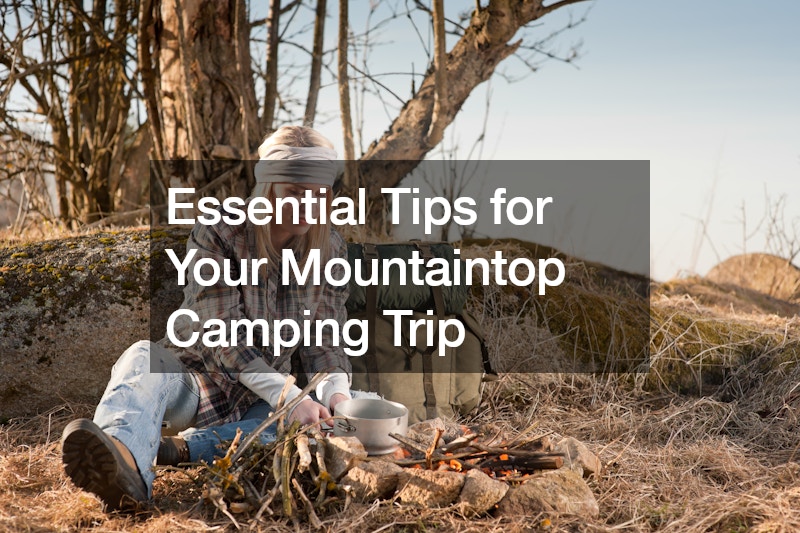
Adventures provide people with a much-needed break in life. Stress from responsibilities from multiple angles will become a part of the daily routine. According to a 2023 The Healthy Magazine study, people should take two vacations yearly for physical and mental health recovery. Vacation trips can be exciting, even during the planning stages. You have something to look forward to, allowing you to take a break even when you are not on your break days.
Of course, vacations are not only for relaxation. Beaches and resorts are often the first choice for most people, but you can make it into an adventurous event. One of the most popular choices for those adventures is mountaintop camping. Going to the mountains, being one with nature, and exploring the urban environment’s dark setting can excite you, pumping adrenaline into your system. However, the unpredictability of mountaintop camping can be challenging, making it necessary to learn and prepare as much as possible. Failing to do so can make your vacation a hassle, and you already have enough of that at work and home. Here are a few tips to help you enjoy your mountaintop camping trip.
Research the Area

Mountaintop camping can be fun, but failing to research the location thoroughly can lead to dire consequences. Inadequate preparation may result in unpredictable weather conditions, catching campers off guard and exposing them to harsh elements such as extreme cold, high winds, or sudden storms. Insufficient knowledge of the terrain and potential hazards can also lead to accidents, making the experience uncomfortable and difficult. Without proper research, climbers might find themselves ill-equipped to handle the challenges that a mountaintop environment presents, jeopardizing their safety and the overall enjoyment of the journey.
You must research thoroughly to ensure a successful and enjoyable mountaintop camping experience. Understanding the chosen mountain’s climate, wildlife, and geographical features is crucial for planning the appropriate gear, clothing, and emergency provisions. Furthermore, researching the specific regulations and permits required for the area promotes responsible and sustainable outdoor practices. Additionally, identifying suitable camping spots fosters a sense of bonding with nature, as campers can appreciate and respect the ecosystem’s delicate balance. By researching the location, mountaintop climbers can create lasting memories while ensuring safety and environmental consciousness.
Watch for Flash Floods
Mountaintop camping can be exciting and beneficial for people, especially when enjoying the breathtaking views and scenery. However, it comes with substantial risks that even the most prepared can struggle with, especially flash floods. Heavy rainfall, melting snow, or storms upstream can quickly elevate water levels in mountainous areas, overwhelming narrow canyons and valleys. The combination of steep terrain and the rapid water flow increases the risk of flash floods during mountaintop camping expeditions. Awareness of these dangers is crucial for adventurers seeking the thrill of high-altitude camping.
In a flash flood during mountaintop camping, it’s vital to prioritize safety. Stay informed about weather forecasts, especially in mountainous regions prone to sudden weather shifts. Set your campsite away from potential flood zones, avoiding low-lying areas and riverbanks. If a flash flood is imminent, quickly move to higher ground and never attempt to cross swiftly flowing water. Having emergency supplies, communication devices, and knowing about evacuation routes can make a significant difference. Additionally, you should check with local flash flood damage companies for real-time alerts and guidance to enhance your preparedness for any unexpected challenges.
Put Out Fires
Mountains, with their rugged terrains and abundant vegetation, often possess a combination of factors that make them susceptible to wildfires. The earthy and wooden elements prevalent in mountainous regions create an environment conducive to fire. Dry vegetation, such as grasses and shrubs, can fuel the rapid spread of flames. Additionally, dead trees and accumulated debris further heighten the risk of ignition. The elevation and diverse topography of mountains can also contribute to the erratic behavior of wildfires, making them challenging to contain and control. Understanding these factors is crucial to create prevention and mitigation strategies for those living near or running a fire damage business in mountainous areas.
When engaging in mountaintop camping, it’s essential to be well-prepared for the potential threat of wildfires. Start by checking local fire regulations and weather conditions before setting up camp. Create a defensible space by clearing dry leaves and vegetation around your campsite, maintaining a safe distance from flammable materials. In case of a fire, prioritize personal safety by evacuating immediately and notifying authorities. Equip yourself with a portable emergency kit, including essentials like bottled water, first aid supplies, and wireless devices. Staying informed and practicing responsible camping habits helps protect the environment and those who enjoy the trip.
Bring Weather Resistant Equipment\

When gearing up for mountaintop camping, investing in weather-resistant equipment is vital. Mountaintops are notorious for sudden shifts in weather conditions, ranging from intense sun to unexpected rain or even snow. This can pose a significant challenge for campers, potentially compromising the durability and effectiveness of standard camping gear. Without weather-resistant equipment, exposure to moisture, extreme temperatures, and strong winds can quickly degrade the performance of your gear, leaving you vulnerable to the harsh elements and diminishing the overall camping experience.
Sourcing weather-resistant equipment from reliable suppliers is crucial to ensure a successful and comfortable mountaintop camping adventure. Consider visiting a ranch store, which often stocks a diverse range of camping gear designed to withstand the rigors of outdoor conditions. These specialized stores cater to outdoor enthusiasts, offering a selection of durable tents, waterproof clothing, and other weather-resistant accessories.
Be Aware of Wildlife
The scenic landscape can be fun to think about, providing a serene environment for mountaintop campers. However, the seemingly tranquil setting can be deceiving, as mountaintops are often teeming with wildlife. It’s crucial not to underestimate the presence of creatures in these elevated regions. From curious marmots to elusive mountain goats, the wildlife at such altitudes is diverse and can catch campers off guard. Birds of prey, like hawks and eagles, may soar overhead, while smaller mammals, such as squirrels and pikas, might scamper around the rocky terrain. Understanding the potential encounters with wildlife is essential to fully appreciating the natural beauty of mountaintop camping.
Taking preventive measures is imperative to prepare for wildlife encounters during mountaintop camping. Begin by researching the specific wildlife species in the area you plan to camp. Familiarize yourself with their behaviors, habits, and potential dangers they may pose. Secure food and trash properly to avoid attracting unwanted attention from animals. Additionally, invest in bear-resistant containers and practice proper food storage techniques. Equipping yourself with bear spray or other deterrents can provide an added layer of safety. Finally, maintain a respectful distance from wildlife, refraining from feeding or approaching them.
Stay On Trails
Mountaintop camping will expose you to many fun activities, and hiking is among the most recognized. The sense of adventure, with the serene landscapes and fresh mountain air, creates an unparalleled opportunity for exploration. Whether trekking through dense forests or ascending to panoramic mountaintop vistas, each step unveils a new perspective. Mountaintop camping allows you to witness stunning sunrises and starlit nights and perhaps even encounter rare wildlife. The allure of discovering hidden gems and untouched land clearing sites amplifies the joy of the journey, making hiking an indispensable part of the mountaintop camping experience.
However, the thrill of exploration must be balanced with a commitment to environmental stewardship and safety. Staying on guided trails is essential to preserve the delicate ecosystems and prevent habitat disruption. Straying off the designated path can lead to soil erosion, damage to fragile vegetation, and disturbance to wildlife. Additionally, maintaining a clear trail helps ensure the safety of hikers by preventing accidents and facilitating efficient rescue operations if needed. While mountaintop camping invites the thrill of discovery, adhering to established trails remains crucial for preserving nature’s wonders.
Wear Comfortable Footwear

Wearing the proper footwear while ascending a mountaintop is often an underrated aspect of the adventure, but it can significantly enhance the experience, especially when accompanied by fellow climbers. The right shoes provide comfort and support and contribute to the group’s safety and camaraderie. Everyone wearing suitable footwear establishes a sense of unity, ensuring that the pace and progression are harmonized. This shared commitment to proper gear fosters a positive environment where everyone can focus on the breathtaking journey rather than dealing with discomfort or potential injuries. For mountaintop camping, proper footwear becomes a crucial part of the collective experience, enhancing the bond among climbers and creating lasting memories.
When selecting footwear for mountaintop adventures, several elements should be considered. Sturdy soles with reliable traction are essential for navigating varied terrains, providing stability on rocky paths or slippery surfaces. Waterproof or water-resistant materials protect against unexpected weather changes and stream crossings during the ascent. Additionally, proper ankle support helps prevent injuries on uneven ground. Ventilation is crucial for comfort, especially during extended hikes, ensuring that feet remain dry and blister-free. By paying attention to these elements and considering expert advice from specialized apparel stores, climbers can elevate their mountaintop camping experience.
Pack Extra Clothes
Mountaintop camping poses unique challenges that underscore the importance of careful clothing preparation. Weather conditions at higher altitudes can be unpredictable, ranging from scorching sun to chilly winds and sudden rainstorms. Consequently, a well-thought-out selection of clothing becomes essential to address the diverse climatic shifts. Lightweight, moisture-wicking layers are crucial to manage body temperature, while waterproof outer layers shield against unexpected rainfall. It’s not just about comfort; it’s about ensuring your safety and well-being in the face of the mountain’s erratic climate.
When gearing up for mountaintop camping, packing extra clothes becomes a strategic move. The absence of a nearby laundromat or washing facilities means you won’t have the luxury of conveniently cleaning your garments. Having spare sets of clothing not only extends the duration of your stay without worrying about laundry logistics but also provides a buffer against unforeseen weather changes or accidental spills.
Bring Essential Items
Thoughtful packing becomes the cornerstone of a successful outdoor living experience. The mountainous terrain, with its unpredictable weather and challenging conditions, demands careful consideration of the essentials. A well-prepared backpack ensures your comfort and plays a pivotal role in your safety amid the rugged beauty of high-altitude camping.
As you prepare for your mountaintop camping journey, prioritize items that cater to the demands of outdoor living in this unique environment. Start with reliable shelter, a sturdy tent designed for mountain conditions, protection from the elements, and insulation against chilly temperatures. Pack a high-quality sleeping bag suitable for cold nights and layers of clothing to adapt to varying weather patterns. Nutrition-packed, lightweight meals are crucial for sustaining energy levels during hikes and ensuring a seamless outdoor living experience. Equip yourself with navigation tools, a first aid kit, and a reliable water purification system to navigate the challenges of mountaintop camping safely.
Check for Parasites

Nearly every step you make to prepare for a mountaintop camping trip can be fun, but there might be a few tasks you might not enjoy. One particular concern during mountaintop excursions is the presence of parasites. Ticks, for instance, are common in wooded areas, even at higher altitudes. These tiny arachnids latch onto unsuspecting hikers and can transmit various diseases. Additionally, mosquitoes may persist near water sources, carrying the risk of spreading infections. While the altitude might deter some pests, you must remain vigilant and take camping precautions to ensure a pest-free camping experience.
Effective pest removal strategies are paramount for an enjoyable mountaintop camping trip. Start by wearing long camping sleeves and pants and using insect repellent to minimize skin exposure. Consider treating clothing with permethrin, a potent insect repellent that creates an additional barrier against ticks and other pests. Choose camping spots away from stagnant water sources to reduce the likelihood of encountering mosquitoes. Regularly inspect yourself and your gear for ticks, removing them promptly with fine-tipped tweezers to prevent the transmission of diseases.
Camping at the mountaintop can be fun, but you must ensure you prepare for it carefully. The fun experience you may have might get ruined because of missing gear, a challenging weather predicament, or an uncomfortable situation when you miss those essential steps. When you prepare properly, you can enjoy the scenic and breathtaking views that the mountaintops can provide.


